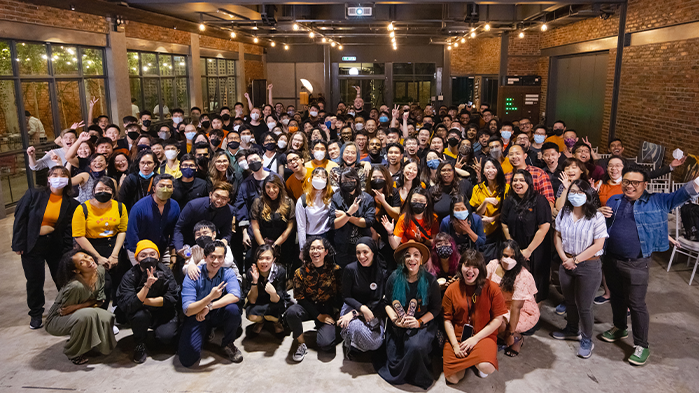This is evident when you consider the demise of companies and recently canceled projects. A survey conducted by the XDS at the end of March 2020, revealed that, despite the health concerns, only 47% of the surveyed game developers/publishers provided the option to work from home for their external partners. Instead, many developers and publishers mitigated the impact of global lockdowns by shifting work to less affected regions, decreasing games' scope, or delaying releases. Even big industry players like Technicolor are now facing solvency issues. We also saw a small portion who chose to ignore public health risks and continue to have their teams work at the office, putting their profits above their employees' safety and well-being. Actions like these only further add to the games industry’s bad reputation.
Lastly, COVID-19 has led to the cancellation of physical tradeshows, with many moving to a fully digital model. This means that companies that previously relied heavily on tradeshows for business development now find it challenging to chase new leads and close deals. The hardest hit are probably indie developers who depended on tradeshows to secure funding from potential investors and publishers.
What does this mean for our industry as a whole? And how should we move forward?
1. Contracts and agreements matter (and always have)
For many, it took the global pandemic to realize the importance of agreements. Especially when projects canceled or deliveries fell through. While there are many things to pay attention to in contracts, I’ll focus on the two that I feel are most relevant during this time. Firstly, the Force Majeure clause. The Force Majeure clause protects parties involved in a contract when extraordinary circumstances prevent contractual commitments from being met. Imagine being a service provider or developer who had to halt operations, even temporarily, due to lockdowns. The Force Majeure clause could mean the difference between your company going bankrupt due to failure to deliver milestones or the survival of your company.
The inability to fulfill contractual requirements is also where the Limitations of Liabilities clauses are also significant. You need to know how much damage you will have to pay or are eligible to receive for non-delivery (depending on which side of the agreement you are on). Both parties need to negotiate this clause thoughtfully at the start of the contract to ensure that they do not become financially bankrupt by a failure to deliver. Also, question whether the sum agreed upon can be paid. We've seen contracts that ask for sums that would not be possible to be covered by insurance.
2. Business development
Without shows to go to, sales teams have had to shift back to using emails and cold calls to reach out to potential partners. Gone are the networking events and parties where you could easily find like-minded individuals and potential partners. This also means that sales tools such as LinkedIn and social media have become essential to make these connections, and for securing revenue.
Apart from tools, the organization of sales teams will also need to change. In the past, companies could rely on single sales teams or even an individual sales-representative that traveled to different shows to meet partners in different regions. The cancellation of physical shows and the shift to digital events have made the events less effective for business development. The main problem with shifting to digital-only is the time-zone difference between attendees. From personal experience, arranging calls and meetings during these digital events is almost impossible, as time-zones rarely line up for all parties.
Companies can mitigate this and shrug off their reliance on tradeshows by having regionally distributed business development teams. This way, calls, and virtual meetings can happen at more productive hours and, in those regions where travel is opening up, face-to-face meetings will be easier to arrange. Otherwise, you will have a sales team that is going to be up at odd hours doing business development virtually.
3. More nuanced partner and team management
The global pandemic has caused many companies to shift to a work-from-home (WFH) model. While there are many benefits to working from home, it is undeniable that peoples’ moods and mental states are different compared to when we were all in an office. Some people find it hard to stop working, while others have a harder time balancing work and family since now there is no physical separation.
It has never been more important to read the room and mood of the people you work with, especially, when you cannot meet in person. We must spend the extra time and effort building and maintaining relationships to ensure that issues are dealt with quickly and effectively. It is all too easy to hide behind chats and emails. For example, I volunteered to one of our partners to have a call at an odd hour for me. There was an issue because of time-zone differences. It was hard to set up a call and emails were proving ineffective. While I wouldn’t make a habit of taking calls at odd hours, it was needed in this case for us to proceed and our relationship grew stronger because of it.
Small acts that add to the emotional bank accounts are even more critical now as minor issues tend to get blown out of proportion because of the added stress and uncertainty everyone faces.
4. Hiring needs
As a hiring manager, our teams' ability to work from home is both liberating and stressful. On the one hand, it opens up a broader pool to find candidates. On the other, it means that there are new considerations to look out for.
The first, and I think most important, is that candidates must be more self-directed, proactive, communicative, and disciplined than before. Without the physical proximity and supervision that you would have in an office, team members may not be able to perform as well as they used to. In our experience, we have seen both ends of the spectrum. Some of our employees have increased performance and productivity after shifting to work from home. For others, their performance took a nosedive. Ultimately, it comes down to the mental fortitude and grit of individuals.
Apart from soft skills, we should also consider candidates based on their living situation. They need to have a good working environment at home where they can focus and have access to a good internet connection. By having a dedicated space to work from also reduces the chances of family members or other outsiders seeing confidential material or interrupting calls.
5. Magnified security concerns
Related to the above point, the shift to WFH means that security becomes a much bigger focus. While there are many ways to ensure security and performance from an IT standpoint, the different project and individual needs make it difficult to have a blanket one size fits all work from home solution. Teams will just have to find what works best for them. Things like bandwidth and latency are heavily dependent on the internet connection at your employees' homes. It may be too unstable for some individuals to work reliably remotely.
Apart from just the technical aspects of security and performance. Employees must adapt their home workspaces and interactions with household members to ensure they don't breach confidentiality rules. We have all seen embarrassing moments on conference calls from home where someone walks into the frame or a cat or child calls the speaker's attention away—depending on the situation that could be understood or it could make or break a project. This is why that it is just as important to ensure that you have the proper process and policies in place to govern work from home and to give employees the necessary training and guidance on how to adhere to best practices.
6. Rethinking large scale productions
Distributed development means that coordination has become a more time consuming and complicated process. In essence, it has paradoxically opened access to a global talent pool but made it more challenging to coordinate said talent pool.
The health risks associated with COVID-19 has also made it less likely that studios or outsource houses with hundreds or thousands of people under one roof will continue to exist the way that they have in the past. The risk to human life is just too high. Productions that require massive amounts of manpower need to be reassessed. Developers and publishers alike have to consider the impact of another disruption of this scale; could they handle postponed or canceled releases? How long can they sustain resources and funds?
To mitigate this, developers will consider distributing larger chunks of creative and technical control to external partners, instead of the current model, where a single central developer handles all the integration and implementation in the end. This will bring us closer to the idea of true distributed development, where the development and partnerships can happen on a worldwide stage. The skillsets to create games exist globally. It is now time to leverage it.
Another means to mitigate the risk of large productions would be to have fewer of them. Developers will start shifting to producing games that will be achievable with 2-3 years of production. This way, the investment, and risk are reduced.
COVID-19 continues to cause global disruptions. As with any disaster of this magnitude. It forces us to adapt as individuals and businesses. By challenging us, it becomes the catalyst for us to improve and change ourselves in ways we did not previously consider. The pandemic has brought to the forefront issues that needed addressing. We should take this time to reflect, we can move forward and come out the other side better than when we came in.






